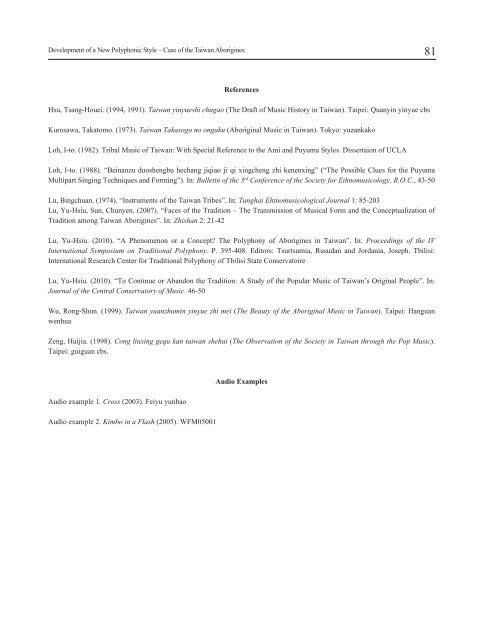The Fifth International Symposium on Traditional Polyphony ...
The Fifth International Symposium on Traditional Polyphony ... The Fifth International Symposium on Traditional Polyphony ...
80 Yu-Hsiu Lu earliest tribes in the island that accepted the western (i.e. the mainstream) culture for a reason – their music and the western mainstream pop music share a similar sound. Writing new lyrics in their native language and filling them into pieces of existing foreign melodies is one of the traditional ways of Amis composition. However, they arrange every piece in their own polyphonic style. But from 1990s, they started to take a different approach.
Development of a New Polyphonic Style – Case of the Taiwan Aborigines References Hsu, Tsang-Houei. (1994, 1991). Taiwan yinyueshi chugao (
- Page 30 and 31: 30 Joseph Jordania gestion not only
- Page 32 and 33: 32 virtualuri heterofonia: kompozic
- Page 34 and 35: 34 munir nuretin bekeni (aSS) migvi
- Page 36 and 37: 36 MÜNIR NURETTIN BEKEN (USA) VIRT
- Page 38 and 39: 38 Münir Nurettin Beken This becam
- Page 40 and 41: 40 munir nuretin bekeni. danarTi M
- Page 42 and 43: 42 nino ciciSvili (avstralia, saqar
- Page 44 and 45: 44 nino ciciSvili (2) reCitaciuli b
- Page 46 and 47: 46 nino ciciSvili upirveles yovlisa
- Page 48 and 49: 48 nino ciciSvili kulturis arsebobi
- Page 50 and 51: 50 NINO TSITSISHVILI (AUSTRALIA, GE
- Page 52 and 53: 52 Nino Tsitsishvili Factor 3: scal
- Page 54 and 55: 54 Nino Tsitsishvili A historical i
- Page 56 and 57: 56 Nino Tsitsishvili References Ale
- Page 58 and 59: 58 kunZul balis gamelanis musikis p
- Page 60 and 61: 60 maikl tenzeri saciis xangrZliobi
- Page 62 and 63: 62 maikl tenzeri arsebobas, Sreebs
- Page 64 and 65: 64 Michael Tenzer repeats cyclicall
- Page 66 and 67: 66 Michael Tenzer pulsations serves
- Page 68 and 69: 68 maikl tenzeri. danarTi Michael T
- Page 70 and 71: 70 magaliTi 4. bgeris simaRlis, dro
- Page 72 and 73: 72 iu-siu lu Tsou (Tsou) 6 733 seis
- Page 74 and 75: 74 iu-siu lu sawyis etapze taivanel
- Page 76 and 77: 76 iu-siu lu 4 paralelur kvartebsa
- Page 78 and 79: 78 Yu-Hsiu Lu in Taiwanese aborigin
- Page 82 and 83: 82 iu-siu lu. danarTi Yu-Hsiu Lu. A
- Page 84 and 85: 84 marina qavTaraZe, ekaterine buCu
- Page 86 and 87: 86 marina qavTaraZe, ekaterine buCu
- Page 88 and 89: 88 marina qavTaraZe, ekaterine buCu
- Page 90 and 91: 90 marina qavTaraZe, ekaterine buCu
- Page 92 and 93: 92 Marina Kavtaradze, Ekaterine Buc
- Page 94 and 95: 94 Marina Kavtaradze, Ekaterine Buc
- Page 96 and 97: 96 Marina Kavtaradze, Ekaterine Buc
- Page 98 and 99: 98 rie koCi akompanementiT, instrum
- Page 100 and 101: 100 cxr. 3 rie koCi 1) kanonuri uko
- Page 102 and 103: 102 rie koCi rasac mReroda wamyvani
- Page 104 and 105: 104 ON THE POLYPHONIC SINGING STYLE
- Page 106 and 107: 106 singing the same melody followi
- Page 108 and 109: 108 Rie Kôchi 3. Recent movements
- Page 110 and 111: 110 Rie Kôchi Kôchi, Rie. (ed.).
- Page 112 and 113: 112 rie koCi. danarTi Rie Kôchi. A
- Page 115 and 116: 115 ala sokolova (adiRe, ruseTi) ad
- Page 117 and 118: adiReas tradiciuli kulturis ameburi
- Page 119 and 120: adiReas tradiciuli kulturis ameburi
- Page 121 and 122: adiReas tradiciuli kulturis ameburi
- Page 123 and 124: 123 ALLA SOKOLOVA (RUSSIA, REPUBLIC
- Page 125 and 126: The Meanings and C
- Page 127 and 128: The Meanings and C
- Page 129 and 130: The Meanings and C
Development of a New Polyph<strong>on</strong>ic Style – Case of the Taiwan Aborigines<br />
References<br />
Hsu, Tsang-Houei. (1994, 1991). Taiwan yinyueshi chugao (<str<strong>on</strong>g>The</str<strong>on</strong>g> Draft of Music History in Taiwan). Taipei: Quanyin yinyue cbs<br />
Kurosawa, Takatomo. (1973). Taiwan Takasogo no <strong>on</strong>gaku (Aboriginal Music in Taiwan). Tokyo: yuzankako<br />
Loh, I-to. (1982). Tribal Music of Taiwan: With Special Reference to the Ami and Puyuma Styles. Dissertai<strong>on</strong> of UCLA<br />
Loh, I-to. (1988). “Beinanzu duoshengbu hechang jiqiao ji qi xingcheng zhi kenenxing” (“<str<strong>on</strong>g>The</str<strong>on</strong>g> Possible Clues for the Puyuma<br />
Multipart Singing Techniques and Forming”). In: Bulletin of the 3 rd C<strong>on</strong>ference of the Society for Ethnomusicology, R.O.C., 43-50<br />
Lu, Bingchuan. (1974). “Instruments of the Taiwan Tribes”. In: Tunghai Ehtnomusicological Journal 1: 85-203<br />
Lu, Yu-Hsiu, Sun, Chunyen. (2007). “Faces of the Traditi<strong>on</strong> – <str<strong>on</strong>g>The</str<strong>on</strong>g> Transmissi<strong>on</strong> of Musical Form and the C<strong>on</strong>ceptualizati<strong>on</strong> of<br />
Traditi<strong>on</strong> am<strong>on</strong>g Taiwan Aborigines”. In: Zhishan 2: 21-42<br />
Lu, Yu-Hsiu. (2010). “A Phenomen<strong>on</strong> or a C<strong>on</strong>cept? <str<strong>on</strong>g>The</str<strong>on</strong>g> Polyph<strong>on</strong>y of Aborigines in Taiwan”. In: Proceedings of the IV<br />
<str<strong>on</strong>g>Internati<strong>on</strong>al</str<strong>on</strong>g> <str<strong>on</strong>g>Symposium</str<strong>on</strong>g> <strong>on</strong> Traditi<strong>on</strong>al Polyph<strong>on</strong>y. P. 395-408. Editors: Tsurtsumia, Rusudan and Jordania, Joseph. Tbilisi:<br />
<str<strong>on</strong>g>Internati<strong>on</strong>al</str<strong>on</strong>g> Research Center for Traditi<strong>on</strong>al Polyph<strong>on</strong>y of Tbilisi State C<strong>on</strong>servatoire<br />
Lu, Yu-Hsiu. (2010). “To C<strong>on</strong>tinue or Aband<strong>on</strong> the Traditi<strong>on</strong>: A Study of the Popular Music of Taiwan’s Original People”. In:<br />
Journal of the Central C<strong>on</strong>servatory of Music. 46-50<br />
Wu, R<strong>on</strong>g-Shun. (1999). Taiwan yuanzhumin yinyue zhi mei (<str<strong>on</strong>g>The</str<strong>on</strong>g> Beauty of the Aboriginal Music in Taiwan). Taipei: Hanguan<br />
wenhua<br />
Zeng, Huijia. (1998). C<strong>on</strong>g liuxing gequ kan taiwan shehui (<str<strong>on</strong>g>The</str<strong>on</strong>g> Observati<strong>on</strong> of the Society in Taiwan through the Pop Music).<br />
Taipei: guiguan cbs.<br />
Audio example 1. Cross (2003). Feiyu yunbao<br />
Audio example 2. Kimbo in a Flash (2005). WFM05001<br />
Audio Examples<br />
81



